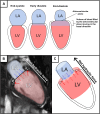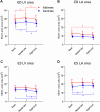Exercise cardiovascular magnetic resonance shows improved diastolic filling by atrioventricular area difference in athletes and controls
- PMID: 39417822
- PMCID: PMC11687837
- DOI: 10.1152/japplphysiol.00446.2024
Exercise cardiovascular magnetic resonance shows improved diastolic filling by atrioventricular area difference in athletes and controls
Abstract
Hydraulic force, a novel mechanism shown to aid diastolic filling, can be calculated by assessing the geometrical relationship between the left ventricular and atrial short-axis areas (atrioventricular area difference, AVAD) (Maksuti E, Carlsson M, Arheden H, Kovács SJ, Broomé M, Ugander M. Sci Rep 7: 43505-43510, 2017; Steding-Ehrenborg K, Hedström E, Carlsson M, Maksuti E, Broomé M, Ugander M, Magnusson M, Smith JG, Arheden H. J Appl Physiol (1985) 130: 993-1000, 2021). During exercise both ventricular and atrial volumes change due to altered loading conditions compared with rest, but it is unknown to what extent this affects AVAD. The aim of this study was to investigate whether AVAD differs when going from rest to exercise in sedentary controls and athletes. We included 13 sedentary controls and 20 endurance athletes to undergo cardiovascular magnetic resonance (CMR) imaging at rest and during moderate and vigorous exercise using a CMR-compatible ergometer. AVAD was calculated as the largest ventricular short-axis area minus the largest atrial short-axis area in end-diastole (ED) and end-systole (ES) as measured from CMR short-axis images. AVAD in ED increased during moderate exercise in both sedentary controls and athletes, thus aiding diastolic filling, but did not increase further during vigorous exercise. AVAD in ES was negative in both groups at rest and decreased further with increasing exercise intensity in sedentary controls, whereas athletes remained unchanged. In conclusion, results from AVAD in ED indicate the net hydraulic force to further augment diastolic filling during moderate exercise when compared with rest, providing new insights into the mechanism by which diastolic function increases during exercise.NEW & NOTEWORTHY This study is the first to assess hydraulic force during exercise, a novel mechanism shown to augment diastolic filling at rest. Our results indicate hydraulic force to further aid in diastolic filling during moderate exercise compared with rest in athletes and sedentary controls, providing new insights into the mechanism by which the left ventricle increases diastolic function during exercise.
Keywords: atrioventricular area difference; exercise cardiac magnetic resonance imaging; hydraulic force; left atrium; left ventricle.
Conflict of interest statement
Einar Heiberg is the founder of software company Medviso AB, which develops the software Segment that was used in the image analysis in the current study. None of the other authors has any conflicts of interest, financial or otherwise, to disclose.
Figures






Similar articles
-
Atrioventricular Area Difference Aids Diastolic Filling in Patients with Repaired Tetralogy of Fallot.Pediatr Cardiol. 2025 Jun;46(5):1163-1170. doi: 10.1007/s00246-024-03508-7. Epub 2024 May 28. Pediatr Cardiol. 2025. PMID: 38806793 Free PMC article.
-
Left Ventricular Diastolic Function in Children with Atrial Septal Defects Improves After Closure by Means of Increased Hydraulic Force.Pediatr Cardiol. 2025 Jun;46(5):1194-1201. doi: 10.1007/s00246-024-03534-5. Epub 2024 Jun 11. Pediatr Cardiol. 2025. PMID: 38861174 Free PMC article.
-
Hydraulic force is a novel mechanism of diastolic function that may contribute to decreased diastolic filling in HFpEF and facilitate filling in HFrEF.J Appl Physiol (1985). 2021 Apr 1;130(4):993-1000. doi: 10.1152/japplphysiol.00890.2020. Epub 2021 Feb 4. J Appl Physiol (1985). 2021. PMID: 33539261
-
Assessment of left ventricular dimensions and functions in athletes and sedentary subjects at rest and during exercise using echocardiography, Doppler sonography and radionuclide ventriculography.Int J Sports Med. 1996 Nov;17 Suppl 3:S173-9. doi: 10.1055/s-2007-972920. Int J Sports Med. 1996. PMID: 9119539 Review.
-
Detection of cardiovascular disease in elite athletes using cardiac magnetic resonance imaging.Rofo. 2013 Dec;185(12):1167-74. doi: 10.1055/s-0033-1350130. Epub 2013 Jul 29. Rofo. 2013. PMID: 23897528 Review.
References
-
- La Gerche A, Claessen G, Van de Bruaene A, Pattyn N, Van Cleemput J, Gewillig M, Bogaert J, Dymarkowski S, Claus P, Heidbuchel H. Cardiac MRI: a new gold standard for ventricular volume quantification during high-intensity exercise. Circ Cardiovasc Imaging 6: 329–338, 2013. doi:10.1161/CIRCIMAGING.112.980037. - DOI - PubMed
MeSH terms
Grants and funding
LinkOut - more resources
Full Text Sources
Medical

